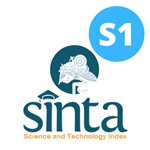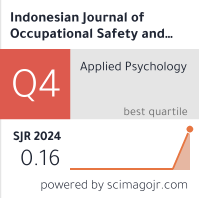Work-Related Health and Burnout Patterns: A Two-Year Longitudinal Analysis of Case Managers and Administrators in Occupational Accident Insurance Services

Downloads
Introduction: Occupational health and safety are important for professionals managing an organization’s workplace accident insurance efforts because their work influences productivity. Therefore, this study will compare the associated health and burnout related to work in case managers and administrators. Methods: A longitudinal design was adopted. This study used year-over-year surveys of 158 employee professionals with 79 case managers and 79 administrators over a two-year time frame. They measured occupational health with the questionnaires Work Ability Index (WAI) and Copenhagen Burnout Inventory (CBI). Occupational health was subsequently studied using linear regression and mixed-effects models. Results: Case managers tend to have higher work ability (mean WAI score: 45.08), but they suffer from more personal burnout (mean PB score: 33.0), presumably because they work directly with injured workers. In contrast, administrators are experiencing lower but more stable levels in their work ability (mean WAI score: 37.78) and with higher levels of client-related burnout (mean CRB score: 53.0). Further, work ability deteriorates as age increases, especially among case managers, and is negatively associated with high BMI, low sleep and long sick leave. Employees with a BMI > 30 had 12% lower WAI scores (p<0.01), and those sleeping < 6 hours per night had 15% lower work ability index. Conclusion: This study emphasizes the need for targeted interventions to alleviate occupational burnout and improve work ability, particularly through occupation-specific workplace interventions. The study also suggests that implementing stress management programs, health promotion initiatives, and workflow optimizations may improve occupational health outcomes.
Adel, M., Akbar, R. and Ehsan, G. (2019) ‘Validity and Reliability of Work Ability Index (WAI) Questionnaire among Iranian Workers; A Study in Petrochemical and Car Manufacturing Industries’, Journal of Occupational Health, 61(2), pp. 165–174. Available at: https://doi.org/10.1002/1348-9585.12028.
Akinbode, G. (2021) Work Leadership, Occupational Health, and Safety, Book Chapter: Research Anthology on Changing Dynamics of Diversity and Safety in the Workforce. pp. 1608-1625 . Available at: https://doi.org/10.4018/978-1-6684-2405-6.ch079.
Alam, M.S. et al. (2024) ‘Motivating Supervisors During Disability Accommodation: A Comprehensive Examination on Job Demand and Resources Theories’, International Journal of Manpower, 45(7), pp. 1385–1408. Available at: https://doi.org/10.1108/IJM-10-2023-0620.
Alshorman, D.Z., Bazzari, A.H. and Bazzari, F.H. (2024) ‘Comprehensive Assessment of Demographic and Occupational Factors Influencing Burnout Amongst Community Pharmacists in Jordan’, Pharmacia, 71, pp. 1–9. Available at: https://doi.org/10.3897/pharmacia.71.e123247.
Amrani, M. et al. (2020) ‘Well-being at Work: A Lever for Sustainable Performance in Workplace’, Mining Science, 27, pp. 89–104. Available at: https://doi.org/10.37190/msc202707.
Arthur, A. et al. (2023) ‘Work ability and Anthropometric Indices Correlate with Cardiovascular Risk Factors in Public Sector Employees: Cross-sectional Study’, Health Science Reports, 6(11). Available at: https://doi.org/10.1002/hsr2.1728.
Athanasou, J. (2024) ‘Introduction to the Work Ability Index – A Guide for Rehabilitation Practitioners’, Qeios, 6(4). Available at: https://doi.org/10.32388/K7MD4D.2.
Bautista-Bernal, I., Quintana-García, C. and Marchante-Lara, M. (2021) ‘Research Trends in Occupational Health and Social Responsibility: A Bibliometric Analysis’, Safety Science, 137, p. 105167. Available at: https://doi.org/10.1016/j.ssci.2021.105167.
Breña, W.H., Burneo, A. and Cassaretto, M. (2022) ‘Translation, Adaptation, and Validation of the Copenhagen Burnout Inventory for the Peruvian Version ’, Revista de Psicologia (Peru), 40(2), pp. 711–738. Available at: https://doi.org/10.18800/psico.202202.003.
Campbell, D.D. et al. (2021) ‘Effects of Increased Body Mass Index on Employment Status: A Mendelian Randomisation Study’, International Journal of Obesity, 45(8), pp. 1790–1801. Available at: https://doi.org/10.1038/s41366-021-00846-x.
Campbell, S. et al. (2020) ‘Purposive Sampling: Complex or Simple? Research Case Examples’, Journal of Research in Nursing, 25(8), pp. 652–661. Available at: https://doi.org/10.1177/1744987120927206.
Chirico, F., Giorgi, G. and Magnavita, N. (2023) ‘Addressing all the Psychosocial Risk Factors in the Workplace Requires a Comprehensive and Interdisciplinary Strategy and Specific Tools’, Journal of Health and Social Sciences, 8(3), pp. 170–174. Available at: https://doi.org/10.19204/2023/DDRS1.
Conica, S., Browne, N. and Danyll, R. (2024) ‘Leveraging Machine Learning to Enhance Occupational Safety and Health in Hospital’, Safety and Health for Medical Workers, 1(2), pp. 78–94. Available at: https://doi.org/10.69725/shmw.v1i2.150.
Fattori, A. et al. (2024) ‘Exploring Workability in an Older Working Population: Associations with Cognitive Functioning, Sleep Quality, and Technostress’, Frontiers in Public Health, 12. Available at: https://doi.org/10.3389/fpubh.2024.1303907.
Fauser, D., Scholz, M. and Wirtz, M.A. (2020) ‘Assessment and Prediction of Burnout According to the Effort–Reward Imbalance Model in a Sample of Healthcare Assistants’, Diagnostica, 66(3), pp. 190–199. Available at: https://doi.org/10.1026/0012-1924/a000247.
Huang, M.-J. (2023) ‘Work-Family Conflict and Burnout among Sports Centers’ Frontline Service employees: Does Service Climate matter?’, Negotiation and Conflict Management Research, 16(4), pp. 267–289. Available at: https://doi.org/10.34891/0hc3-5k96.
Ilea, P. and Ilea, I. (2024) ‘Administrative Burden for Patients in U.S. Health Care Settings Post-Affordable Care Act: A Scoping Review’, Social Science and Medicine, 345. Available at: https://doi.org/10.1016/j.socscimed.2024.116686.
Kalinienė, G. et al. (2024) ‘Does the Level of Burnout Differ between Occupational Groups in Lithuania?’, Frontiers in Public Health, 12. Available at: https://doi.org/10.3389/fpubh.2024.1364886.
Kalski, L. et al. (2024) ‘Efficacy of Occupational Rehabilitation in Return to Work for Back Pain: A Systematic Literature Review’, Work, 78(1), pp. 29–43. Available at: https://doi.org/10.3233/WOR-230277.
Kowalczuk, K., Krajewska-Kułak, E. and Sobolewski, M. (2020) ‘Working Excessively and Burnout among Nurses in the Context of Sick Leaves’, Frontiers in Psychology, 11. Available at: https://doi.org/10.3389/fpsyg.2020.00285.
Kurnianto, A.A. et al. (2023) ‘Managing Disabled Workers due to Occupational Accidents in Indonesia: A Case Study on Return to Work Program’, BMC Public Health, 23(1), p. 943. Available at: https://doi.org/10.1186/s12889-023-15930-2.
King, N (2024) ‘Leading the Way through a Rising Toll of Workplace Stress: How Managers Influence Employees’ Ability to Cope with Job Stress’, Human Resource Management International Digest, 32(4), pp. 16–18. Available at: https://doi.org/10.1108/HRMID-01-2024-0015.
Linaker, C.H. et al. (2020) ‘Body Mass Index (BMI) and Work Ability in Older Workers: Results from the Health and Employment after Fifty (HEAF) Prospective Cohort Study’, International Journal of Environmental Research and Public Health, 17(5), p. 1647. Available at: https://doi.org/10.3390/ijerph17051647.
Lintanga, A.J.J. and Rathakrishnan, B. (2024) ‘The Impact of Psychosocial Safety Climate on Public Sector Job Satisfaction: The Moderating Role of Organizational Climate’, BMC Psychology, 12(1). Available at: https://doi.org/10.1186/s40359-023-01513-8.
Mayasari, N. et al. (2024) ‘The Effect of Technology Integration, Work-Life Balance, and Job Stress on Employee Well-Being in the Art Industry in Jakarta’, West Science Social and Humanities Studies, 2(05), pp. 776–786. Available at: https://doi.org/10.58812/wsshs.v2i05.904.
Mokarami, H., Kalteh, H.O. and Marioryad, H. (2020) ‘The Effect of Work-related and Socio-Demographic Factors on Work Ability Index (WAI) among Iranian workers’, Work, 65(1), pp. 137–143. Available at: https://doi.org/10.3233/WOR-193066.
Navarro-Haro, M.V. et al. (2024) ‘Factors Associated with the Implementation of Dialectical Behavior Therapy by Spanish Speaking Mental Health Professionals who Treat Suicide Risk’, BMC Psychiatry, 24(1). Available at: https://doi.org/10.1186/s12888-024-06243-8.
Pfeffer, J. et al. (2020) ‘Magnitude And Effects Of “Sludge” In Benefits Administration: How Health Insurance Hassles Burden Workers And Cost Employers’, Academy of Management Discoveries, 6(3), pp. 325–340. Available at: https://doi.org/10.5465/amd.2020.0063.
Piperac, P. et al. (2021) ‘The Validity and Reliability of the Copenhagen Burnout Inventory for Examination of Burnout among Preschool Teachers in Serbia’, International Journal of Environmental Research and Public Health, 18(13). Available at: https://doi.org/10.3390/ijerph18136805.
Roskams, M. et al. (2021) Job Demands-Resources Model: Its Applicability to the Workplace Environment and Human Flourishing, A Handbook of Theories on Designing Alignment Between People and the Office Environment. Edited by Appel-Meulenbroek, R. and Danivska, V, pp. 27–38. London: Routledge/Taylor & Francis Group. Available at: https://doi.org/10.1201/9781003128830-3.
Sharpe, K. et al. (2022) ‘Return-to-Work After Work-Related Injury in the Construction Sector: A Scoping Review’, Journal of Occupational Rehabilitation, 32(4), pp. 664–684. Available at: https://doi.org/10.1007/s10926-022-10028-9.
Slowiak, J.M. and Jay, G.M. (2023) ‘Burnout among Behavior Analysts in Times of Crisis: The Roles of Work Demands, Professional Social Support, and Psychological Flexibility’, Research in Autism Spectrum Disorders, 105. Available at: https://doi.org/10.1016/j.rasd.2023.102185.
Slowiak, J.M. and McDonough, M. (2024) ‘Job Burnout, Work Health Management Interference, and Organizational Health Climate Among Employees with Varied Levels of Work Ability’, Journal of Occupational Rehabilitation, 35, pp. 306–319. Available at: https://doi.org/10.1007/s10926-024-10198-8.
Smrekar, M. et al. (2020) ‘Validation of the Croatian Version of Work Ability Index (WAI) in Population of Nurses on Transformed Item-Specific Scores’, Zdravstveno Varstvo, 59(2), pp. 57–64. Available at: https://doi.org/10.2478/sjph-2020-0008.
Teni, F.S. et al. (2025) ‘Factors associated with Self-reported Work Ability among People with Multiple Sclerosis in Sweden’, Multiple Sclerosis Journal - Experimental, Translational and Clinical, 11(1). Available at: https://doi.org/10.1177/20552173241304324.
Tran, T.T.T. et al. (2023) ‘Psychometric Properties and Factor Structure of the Vietnamese Copenhagen Burnout Inventory’, Journal of Occupational Health, 65(1). Available at: https://doi.org/10.1002/1348-9585.12425.
Van Eerd, D. et al. (2024) ‘Return-to-Work Experiences in Ontario Policing: Injured But Not Broken’, Journal of Occupational Rehabilitation, 34(1), pp. 265–277. Available at: https://doi.org/10.1007/s10926-023-10135-1.
Varianou-Mikellidou, C. et al. (2020) ‘Work-related Factors and Individual Characteristics Affecting Work Ability of Different Age Groups’, Safety Science, 128. Available at: https://doi.org/10.1016/j.ssci.2020.104755.
Wang, Y. et al. (2020) ‘A Systematic Review on the Research Progress and Evolving Trends of Occupational Health and Safety Management: A Bibliometric Analysis of Mapping Knowledge domains’, Frontiers in Public Health, 8. Available at: https://doi.org/10.3389/fpubh.2020.00081.
Zetterberg, H. et al. (2023) ‘Psychometric Assessment Of The Swedish Version Of The Work Ability Index In Patients With Chronic Pain In Specialized Care’, Journal of Rehabilitation Medicine, 55. Available at: https://doi.org/10.2340/jrm.v55.7146.

This work is licensed under a Creative Commons Attribution-NonCommercial-ShareAlike 4.0 International License.

In order to be accepted and published by The Indonesian Journal of Occupational Safety and Health, Author(s) who submit an article should complete all the review process. The copyright of received articles assigned to the The Indonesian Journal of Occupational Safety and Health and Department of Safety and Health, Universitas Airlangga as publishers of the journal. The intended copyright includes the rights to publish articles in various forms (including reprints).
The Editorial Team of The Indonesian Journal Of Occupational Safety and Health and Department of Safety and Health strive to ensure that no errors occur in the articles that have been published, both data errors and statements in the article.
Users of this website will be licensed to use materials from this website following the Creative Commons Attribution-NonCommercial-ShareAlike 4.0 International License. No fees charged. Please use the materials accordingly.
------------------------------------------------------------------------------------------------------------------------------------------------------------------------------------------
Attribution ” You must give appropriate credit, provide a link to the license, and indicate if changes were made. You may do so in any reasonable manner, but not in any way that suggests the licensor endorses you or your use.
NonCommercial ” You may not use the material for commercial purposes.
ShareAlike ” If you remix, transform, or build upon the material, you must distribute your contributions under the same license as the original.







 How to Submit Articles in OJS
How to Submit Articles in OJS

























